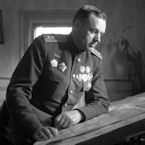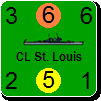BletchleyGeek
Posts: 4713
Joined: 11/26/2009
From: Living in the fair city of Melbourne, Australia
Status: offline

|
Hi janh, long time no see, man 
quote:
ORIGINAL: janh
In a sense I need to agree with your example, BG. I think the GC mid-war isn't as boring as you make it sound, but your example shows a different dynamic: both sides are operating at their limits, constantly near their breaking points, and yet the balance is still near-enough to the mid-ground that no side is immediately facing obvious defeat (and quitting).
Yes, perhaps I was picturing things in a slightly more bleak overtone than I actually wanted to. More than boring I would say "pointless". There's little to no sense of purpose in what one is doing, it's all about getting a reward which lies far, far, far down the road (survival by May 1945). One needs to get some reward from his efforts in a more frequent basis (not too frequent, you don't want those rewards to lose value, either). Otherwise keeping faith after seeing your forces being rolled over time and again becomes quickly a sad thing: imagine yourself in a marriage where there's no love, it's all fights over meaningless things and there's the shadow of a huge mortgage looming over you. The most likely outcome is that one of the two in the relationship decides to move on and try something different 
quote:
ORIGINAL: janh
I think this situation is naturally easier to achieve with a limited scope scenario with a proper force ratio to start with, which renders late 42 and 43 good years since both sides where more or less in strategic stalemate. In the GC, this criterium would be out of question: ultimately we don't want to play chess, but a good representation of that war and it was just not balanced for most part. 1941 needs to be dis-balanced for the Axis to be able to create a stunning offensive, blizzard 41 was dis-balanced to recreate the Soviet counter-offensive, and beyond 43 the game slowly shifts to favor the Soviets to recreate the surge backwards (though most AAR shows that the German Army remains too powerful to really get back far and fast, which I believe still shows that Micheals suggestion of just running as a Soviet in 41 and 42 is still giving away victory -- Michael still has to get his units to Berlin in any AAR, if I am not mistaken).
However, your example shows a major difference to the GC: The GC presently is fought in a political vacuum, there are no soft factors from home front morale, political bickering to the world's opinion driving the VP's or sites. The GC can be played with utmost hindsight, as the generals on both sides themselves would have wanted to fight it if they were left to. Force preservation is the key to both sides, not terrain. Both sides do best to balance their advances and(!) retreats against the costs to get their optimum. It is kind of "an academic" course, kind of sterile.
Time-based VPs as in the smaller scenarios would make more sense, I totally agree. That could chance the dynamic of the GC fundamentally. But unless G&G can be convinced to put another effort into this title, which seems unlikely, it is not going to happen. Yet as a word of warning, we still need to balance the force ratios as well! Else, a new type of VP system won't help the game at all.
As long as Lvov occurs, the Soviet player simply looses the option to hold the south and naturally focuses on the Leningrad delay tactic, and holding Moscow -- focuses on presently somewhat realistically achievable goals against most Axis players. With no forces, but lots of terrain to trade for saving Moscow, this is a no-brainer. Even if you made the VPs costlier there, he'd not have an option: sending more Soviets into the fray south where the terrain makes the Panzers much more dangerous than up north currently means weakening the Leningrad/Moscow match -- he basically would put all on one card, and with the current balance in the game... as unwise as an Axis player putting everything on one card.
Similarly, the 41 blizzard must be discussed. Currently it is just used as an artificial rule to swing the initiative and re-balance from Axis supermen to Soviet supermen for two month, and do so almost independently of the true course preceding this phase. Unless the Soviet side has lost terribly, which happened in a few AARs, the blizzard offensive must take place. And if the Axis player holds fast, it is going to cost him dearly. If the Soviet side is strong, then an Axis running is the only choice.
The effects of this rule are much too strong (for my taste), and for keeping the natural flow of the game. The Soviets ought to be stronger in summer 41 (both units, as well as the issue with the melting pockets), have more replacements to be able to counterattack and fight forward without simultaneously forfeiting the chance to hold Moscow. In essence, they ought to have enough spares to waste units at a high cost -- and in that course make the Axis side overextend and suffer enough casualties so a blizzard offensive becomes viable in first place. And if the Soviets chose the Sir Robin, the blizzard rules ought to be "weak" enough (maybe only affecting attrition, supply, replacements and movement, not CV's at all? Or at max with the February parameters?), that a blizzard offensive against a strong Axis army ought to be less successful, as it probably would have been.
Your answer contains quite a few of the subtetlies that Flavio was pointing at. Let me address the one I have a clear idea how to deal with, which is that of force preservation.
Let's take a look at how scenarios keep the tally of VP's awarded due to enemy losses. From what I can gather - if someone thinks know better, please chime in - it basically amounts to keep track of this amount:
quote:
# infantry losses (KIA) x Inf Multiplier + # AFV losses x AFV Multiplier + #Arty losses x Arty Multiplier + #Aircraft losses x Air Multiplier
The trick here is to handle the Multipliers in a dynamic way. And it all boils down to the "quality" - or rather, the maximum quality your forces can attain. In other words, experience. And what's the upper bound on experience? The much hated and little understood notion of National Morale. Why not have those multipliers to depend on the ratio of NM levels of the respective sides? (In the case of the Axis, late-war soviet, NMs should be weighted according to the relative importance of each country in the OOB).
In this way, at the beginning of the war, the German player has two competing goals - regarding maximizing VP's. On the one hand, to avoid losing too many troops whose quality he won't be really be able to recover. On the other hand, exposing himself to suffer losses trying to destroy the Red Army and capture key Soviet cities, resources and facilities.
This needs to be calibrated so that the Soviet player has an incentive to go "balls to the wall" and throw the kitchen sink at the Germans. And people sending kamikaze PzDivs to take out key airplane factories think twice before doing that. Perhaps - given the German inability to create new counters - the number of unit destroyed needs to be taken into account somehow.
As the war progresses, and the NM levels vary accordingly, the name of the game reverses. Losses for the Soviet side become a concern for the Soviet player because, comparatively speaking, they're more valuable. Somme-like operations need to be prohibitely costly in VP terms, forcing the SU to use more finesse rather than purely attritional frontal tactics (and he should be able to do so, if the SU player is really good).
In other words, it's very easy to be as good as Chuikov and very hard to be as good as Rokossovsky 
In "special periods of the game" (Summer 1941 surprise rules, Blizzard 1941, 1:1->2:1 rule) we should come up with special conditions that ameliorate the distorting effects of these special rules.
< Message edited by Bletchley_Geek -- 8/7/2012 12:36:31 PM >
_____________________________
|
 Printable Version
Printable Version












 )
) 

 New Messages
New Messages No New Messages
No New Messages Hot Topic w/ New Messages
Hot Topic w/ New Messages Hot Topic w/o New Messages
Hot Topic w/o New Messages Locked w/ New Messages
Locked w/ New Messages Locked w/o New Messages
Locked w/o New Messages Post New Thread
Post New Thread